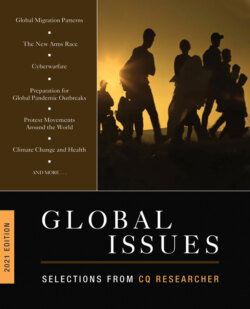Читать книгу Global Issues 2021 Edition - Группа авторов - Страница 56
“Herd Immunity” Acts As Shield
ОглавлениеIt protects those who cannot be vaccinated due to health reasons.
The term “herd immunity” refers to indirect protection from an infectious disease that occurs when a community or a population has near-universal immunity to the disease. It is usually achieved when a certain proportion of individuals in a particular population have been immunized, reducing the incidence of infection and thus protecting the population from new infection. 1
With herd immunity, people who have not themselves been immunized have a lower risk of infection if the virus or disease is introduced into that community. In other words, vaccinations protect not only the immunized individuals but also those with whom they come in contact. Thus, if vaccination rates remain high, the disease becomes rare and may be eliminated altogether. “When a high percentage of people in the community are vaccinated, those vulnerable people who can’t get vaccinated are protected because the virus has no place to spread,” says Dr. Anthony Fauci, director of the National Institute of Allergy and Infectious Diseases.
This community immunity, as it is also known, only works for diseases spread directly between people, such as measles, mumps and rubella. It does not work on tetanus, for example, which is caught from bacteria in the environment.
In the case of measles, most Americans born before the 1970s became immune by contracting and surviving the virus. The first measles vaccine was developed in 1963, and the combined measles, mumps and rubella (MMR) vaccine was introduced in 1971. 2
To achieve herd immunity, all 50 states, the District of Columbia and several U.S. territories require that children entering schools and child care receive the MMR vaccine. That raises the question frequently asked by vaccine skeptics: Why does failing to vaccinate a child pose a risk to him or her and others if the child is protected through herd immunity?
The answer, experts say, is that vaccination is the best protection against a disease. In addition, unless the unvaccinated individual stays in one location, surrounded by the same people, he or she cannot rely on the herd for protection. Traveling to a place with lower vaccine coverage puts the unvaccinated at risk. 3
While vaccine-preventable diseases such as measles are rare in the United States, they are still prevalent elsewhere in the world. The recent measles outbreaks in Washington state and in the ultra-Orthodox communities in New York and New Jersey occurred after vaccination rates dropped and infected travelers brought the virus into the United States, where it took hold in undervaccinated populations.
In addition, some people cannot be vaccinated for health reasons, such as being ill, taking medication that weakens the immune system, being allergic to the vaccine or one of its ingredients or having had a serious reaction to a vaccine in the past. Others are too young to be immunized. Such individuals are most vulnerable to infection and must rely on others for protection.
That protective shield is pierced or compromised when vaccination rates fall below those required to trigger herd immunity. The rate differs according to the disease, but it typically ranges between 90 percent and 95 percent. Because measles is the most infectious of the vaccine-treatable diseases, 93 percent to 95 percent of the population must be immunized for herd immunity to work. For a less contagious disease, such as polio, only 80 percent to 85 percent of the population would need to be vaccinated.
Before the MMR vaccine was introduced, every person with measles would infect another 10-15 people, leading to a rapid spread of the disease. Even a slight decline below the herd immunity threshold puts others at risk, with potentially disastrous consequences. In one 2015 case in China, a single baby with measles infected 23 other children in a pediatric oncology clinic, with a fatality rate of nearly 22 percent.4 The children were too young to be fully vaccinated, and because they had cancer, their immune systems were compromised, so they were doubly at risk.
A study published in the journal JAMA Pediatrics found that a 5 percent reduction in MMR vaccination rates resulted in a threefold increase in annual measles cases. 5
“Herd immunity through high vaccination rates helps minimize transmission of disease to the unvaccinated and people who are at the highest risk of severe infection,” says Dr. Sandra Fryhofer, a member of the board of trustees of the American Medical Association. “Vaccines not only protect the child or adult who receives them but also the health of the community.”
—Melba Newsome
1 Paul Fine, Ken Eames and David L. Heymann, “ ‘Herd Immunity:’ A Rough Guide,” Clinical Infectious Diseases, Vol. 52, Issue 7, April 1, 2011, pp. 911-916, https://tinyurl.com/ydz8mozw.
2 “Vaccine History: Developments by Year,” Children’s Hospital of Philadelphia, undated, https://tinyurl.com/y47ds566.
3 “Measles, Mumps and Rubella (MMR) Vaccination: What Everyone Should Know,” U.S. Centers for Disease Control and Prevention, undated, https://tinyurl.com/y7joyjwh.
4 Y.L. Ge et al., “Measles outbreak in pediatric hematology and oncology patients in Shanghai, 2015,” Chinese Medical Journal, June 5, 2017, https://tinyurl.com/y3762tax.
5 Nathan C. Lo and Peter J. Hotez, “Public Health and Economic Consequences of Vaccine Hesitancy for Measles in the United States,” JAMA Pediatrics, September 2017, https://tinyurl.com/yxfywubx.
“We are in a constant battle between what’s true and not,” says Dr. Robert McLean, President of the American College of Physicians. “The anti-vaxxer stuff is always a challenge because, even when you present [parents] with the facts, they don’t believe them. They think they’re selective facts.”
